In our contemporary world, music is everywhere, every time, brightens up and glorifies our everyday life. From the startups of the Silicon Valley up to the workshops of horology of our valleys, it is not uncommon to cross employees with earphones, which is a tolerated attitude because it seems that music increases productivity! Personally, when I am bustling about late at work, I listen to a hard piece so that I regain energy and inspiration.
Music, just like the Internet or modern medicine, is one of the greatest progresses of our civilization. Our ancestors did not know our happiness, music in the 19th century was so rare, and without our contemporary recording capacity they were dependent upon folk singers, only able to play intoxicating sonorities…
A singing bird is a complex machine where the constraints are quite different from those of a watch. In a watchmaking movement, we seek above all consistency so that an accurate count of the time can be provided whereas in a singing bird mechanism, it is more a matter of generating an important force to animate the bird and to produce the necessary air to produce an audible whistling.
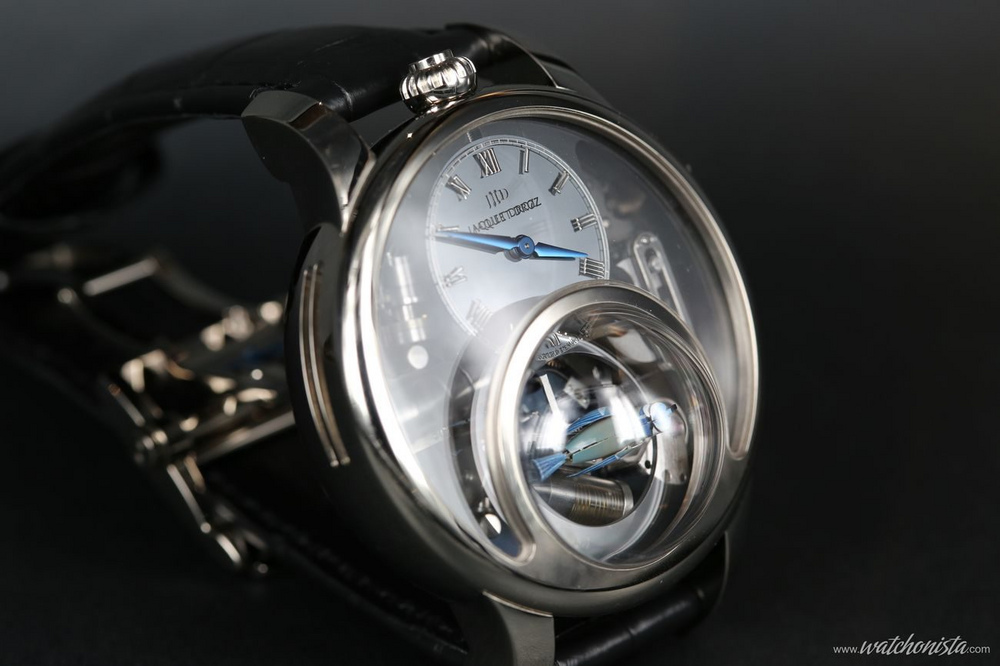
With the techniques of the 19th century, it was easier to obtain force (through heavier springs) than consistency (the quality of the springs, of the barrel, of the balance-springs has penalized chronometry for a long time). It was thus easier and more spectacular to produce a singing bird than a chronometer.
Since then, watchmaking craft has highly evolved, the progresses of metallurgy (elinvar…) and the new precision machines (milionometer…) have made it possible to rise to the double challenge of consistency and miniaturization.
Outshined by the appearance of gramophones at the start of the 20th Century, these singing birds have only marginally beneficiated from these technical progresses.
Jacquet Droz, which was one of the most prestigious mechanics Art house (automata, prostheses, singing birds and horology) wished to dust off the concept of the singing automaton while making it beneficiate from the last technological innovations and thus realizes a tour-de-force by presenting the first watch in history to embark a singing bird: the Charming Bird.

To attain this original musical complication, the Jaquet Droz watchmakers had to go from square one to palliate the relative lack of data about the singing birds automata and answer the miniaturization problematic imposed by the bulk of a wrist watch.
In a traditional singing bird automaton, we wind a lever that winds a complication barrel (like in a traditional minute-repetition) which will provide energy to two distinct parts: the animation of the automaton and the sound of the whistle.
A lamb leather bellows animated by the spring of the barrel provides air to the sound of the whistle. Therefore it is the spring that pumps air in the whistle, the sound is modulated (generally) by a kind of cylinder lined with sprockets; this will produce a melody. As for the bird, it is animated in various positions by a complex automaton system.
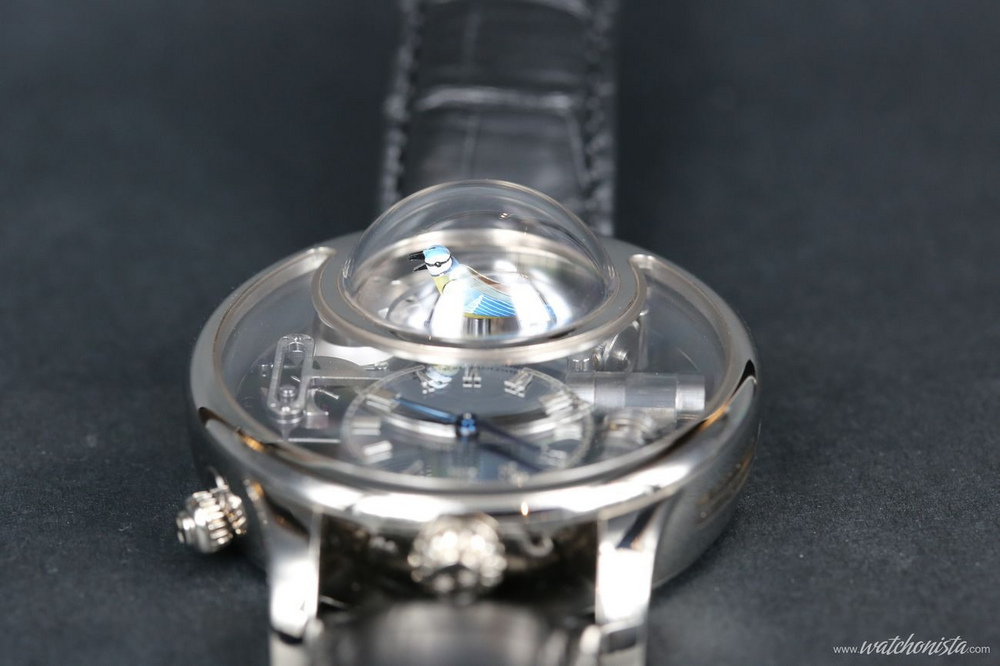
Often, in the mechanical field, the constraints are not proportional but exponential and if the mechanical parts are relatively easy to miniaturise today, it is not the case with the lamb leather part. Another obstacle that needs to be considered to the excessive miniaturization of the traditional system is that the product will be too weak to be audible for a human adult.
To rise to this challenge, the Jaquet Droz watchmakers are inspired by a piston of an internal combustion engine to obtain the same sonorous result as the traditional whistle. The compression ratio of this piston is very close to that of a sporty engine (approximately 1:10). Every organ: pump, air reservoirs and whistle are produced in sapphire in order to limit the frictions to the most.
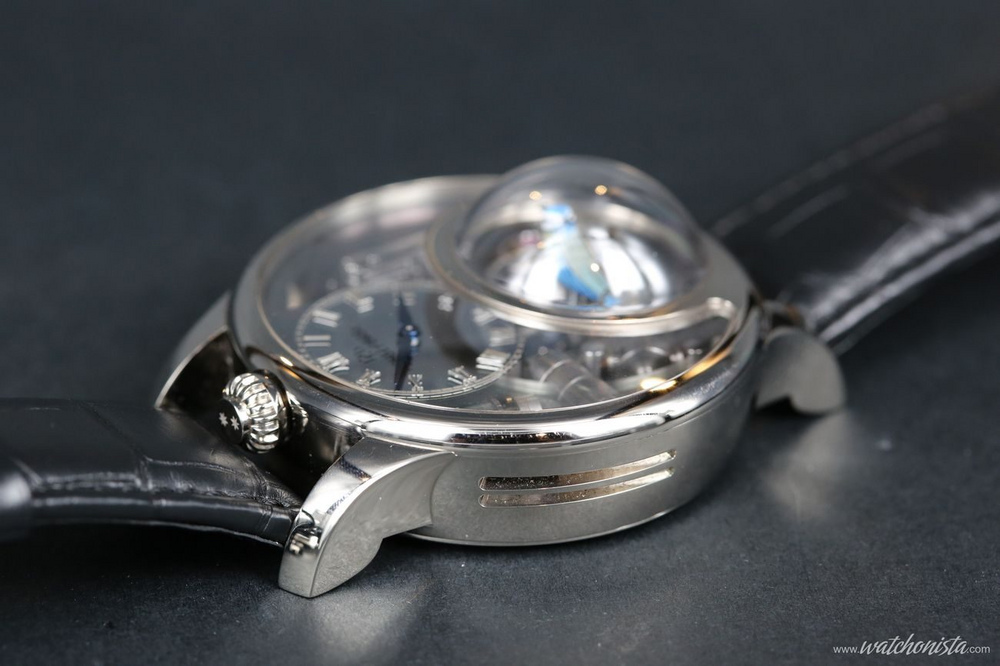
When the push-piece button, which is dedicated to the singing bird, is activated, the cam at 5h moves the piston, which crosses the watch from 3h to 9h. The pump fills the air reservoir, which supplies the melody to the whistle. The complication barrel feeds the automaton bird as much as the whistle: the mechanical ballet impresses while the ballet of the bird dancing to the rhythm of the whistling bewitches.
The bird, rather impressive, is arranged in a dome, which outsteps the surface of the sapphire glass. Such a procedure, destined to reduce the thickness of the case (thus from 22.80mm to 15.65mm), has already been seen in the case of escapement complications but never for a whistling automaton.
To facilitate the sound diffusion, the case has been pierced on the side. This opening was indispensable because contrary to a minute-repetition, there is no resonance phenomenon in the absence of a hammer indirectly hitting the structure of the watch.
The opening is equipped with a musical instrument membrane to prevent dust and light from entering the case. Careful about sudden dives in a pool, the not water-resistant case renders the watch’s mechanism vulnerable to water projections!
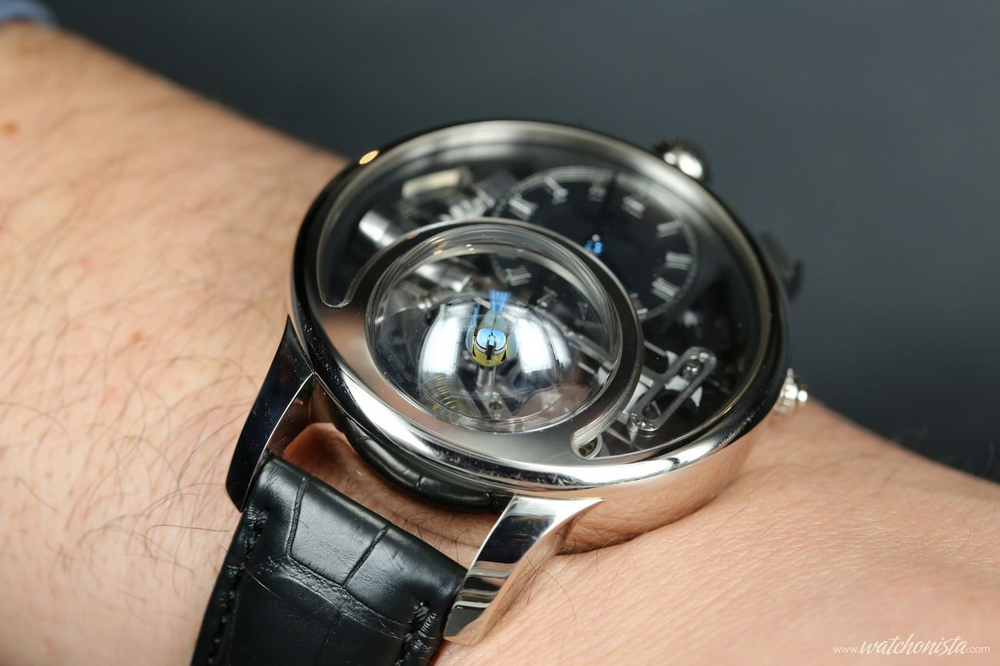
Aside from this specificity, the case is relatively classical, manufactured in white gold, it measures 47mm in diameter. The same concave form is found on the Bird Repeater (link), but where the Bird Repeater was ultra-coloured and more than vintage, the Charming Bird is very sober with its ruthenium finish, which gives the bridges an ultra-contemporary blackened look. Even the finish of the clock dial (at 12h) is very up-to-date.
The numbers seem to levitate upon the dial but contrarily to what could have been seen at Hautlence some years ago, they are not glued on the inside of the glass sapphire. The silver dial is covered with a sapphire plate; the indexes are directly integrated to the latter through a galvanic growth. A novelty? If the bird remains painted to the colours of the **** bird so dear to Jaquet Droz, their lacquered finish is stylistically at the limit of art deco, a mini revolution if we consider that in the great tradition the singing birds are covered with real birds’ feathers.
Between the dome borrowed from the world of independent watchmaking, the blackened finish of the bridges, the indices in levitation and the streamlined **** bird, this watch is a radical aesthetic turn for Jaquet Droz. There had already been somewhat offbeat watches, in particular with ceramic cases, but no product was as futuristic.
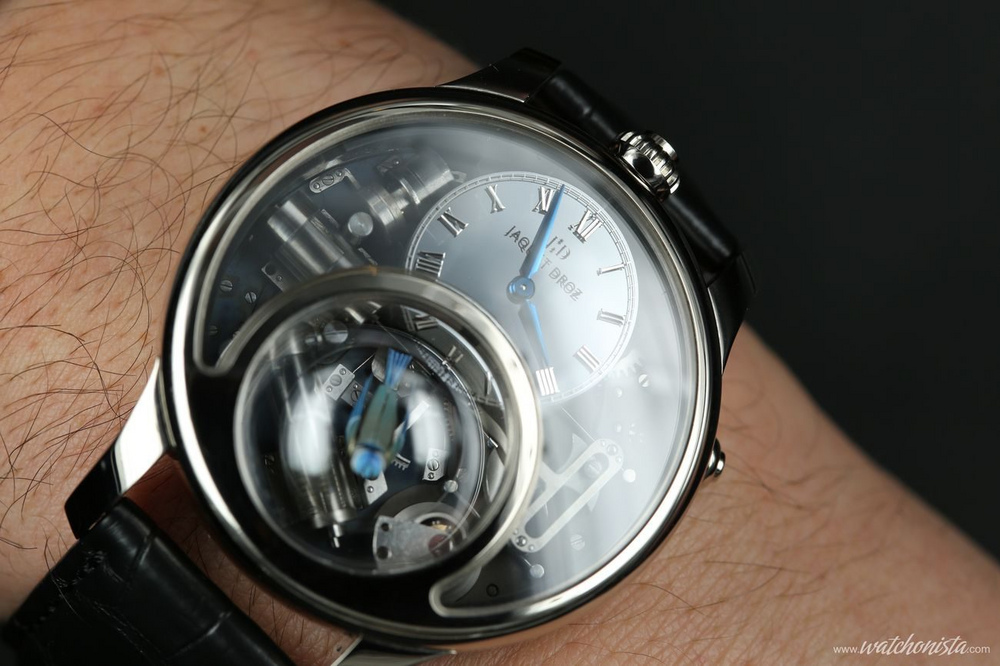
Subjectively, the Charming Bird is a beautiful watch. Objectively, if you think of the success of the Lange’s Zeitwerk Luminous (a contemporary watch in a classic range) the latest high-complication coming from the Jaquet Droz workshops is most likely destined to great success.
But Jaquet Droz, which celebrates the 275 years of its establishment this year, goes further by signing a completely unique complication, a major watch in the history of musical complications. Its only problem is its price: approximately 400k CHF. Both the going rate and the number of copies (28) reserve it to an elite of collectors. With a similar tariff and number of copies the Bird Repeater is already sold out.
To less fortunate watch passionate, Jaquet Droz proposes other pieces:
Music, just like the Internet or modern medicine, is one of the greatest progresses of our civilization. Our ancestors did not know our happiness, music in the 19th century was so rare, and without our contemporary recording capacity they were dependent upon folk singers, only able to play intoxicating sonorities…
A singing bird is a complex machine where the constraints are quite different from those of a watch. In a watchmaking movement, we seek above all consistency so that an accurate count of the time can be provided whereas in a singing bird mechanism, it is more a matter of generating an important force to animate the bird and to produce the necessary air to produce an audible whistling.

With the techniques of the 19th century, it was easier to obtain force (through heavier springs) than consistency (the quality of the springs, of the barrel, of the balance-springs has penalized chronometry for a long time). It was thus easier and more spectacular to produce a singing bird than a chronometer.
Since then, watchmaking craft has highly evolved, the progresses of metallurgy (elinvar…) and the new precision machines (milionometer…) have made it possible to rise to the double challenge of consistency and miniaturization.
Outshined by the appearance of gramophones at the start of the 20th Century, these singing birds have only marginally beneficiated from these technical progresses.
Jacquet Droz, which was one of the most prestigious mechanics Art house (automata, prostheses, singing birds and horology) wished to dust off the concept of the singing automaton while making it beneficiate from the last technological innovations and thus realizes a tour-de-force by presenting the first watch in history to embark a singing bird: the Charming Bird.

To attain this original musical complication, the Jaquet Droz watchmakers had to go from square one to palliate the relative lack of data about the singing birds automata and answer the miniaturization problematic imposed by the bulk of a wrist watch.
In a traditional singing bird automaton, we wind a lever that winds a complication barrel (like in a traditional minute-repetition) which will provide energy to two distinct parts: the animation of the automaton and the sound of the whistle.
A lamb leather bellows animated by the spring of the barrel provides air to the sound of the whistle. Therefore it is the spring that pumps air in the whistle, the sound is modulated (generally) by a kind of cylinder lined with sprockets; this will produce a melody. As for the bird, it is animated in various positions by a complex automaton system.

Often, in the mechanical field, the constraints are not proportional but exponential and if the mechanical parts are relatively easy to miniaturise today, it is not the case with the lamb leather part. Another obstacle that needs to be considered to the excessive miniaturization of the traditional system is that the product will be too weak to be audible for a human adult.
To rise to this challenge, the Jaquet Droz watchmakers are inspired by a piston of an internal combustion engine to obtain the same sonorous result as the traditional whistle. The compression ratio of this piston is very close to that of a sporty engine (approximately 1:10). Every organ: pump, air reservoirs and whistle are produced in sapphire in order to limit the frictions to the most.

When the push-piece button, which is dedicated to the singing bird, is activated, the cam at 5h moves the piston, which crosses the watch from 3h to 9h. The pump fills the air reservoir, which supplies the melody to the whistle. The complication barrel feeds the automaton bird as much as the whistle: the mechanical ballet impresses while the ballet of the bird dancing to the rhythm of the whistling bewitches.
The bird, rather impressive, is arranged in a dome, which outsteps the surface of the sapphire glass. Such a procedure, destined to reduce the thickness of the case (thus from 22.80mm to 15.65mm), has already been seen in the case of escapement complications but never for a whistling automaton.
To facilitate the sound diffusion, the case has been pierced on the side. This opening was indispensable because contrary to a minute-repetition, there is no resonance phenomenon in the absence of a hammer indirectly hitting the structure of the watch.
The opening is equipped with a musical instrument membrane to prevent dust and light from entering the case. Careful about sudden dives in a pool, the not water-resistant case renders the watch’s mechanism vulnerable to water projections!

Aside from this specificity, the case is relatively classical, manufactured in white gold, it measures 47mm in diameter. The same concave form is found on the Bird Repeater (link), but where the Bird Repeater was ultra-coloured and more than vintage, the Charming Bird is very sober with its ruthenium finish, which gives the bridges an ultra-contemporary blackened look. Even the finish of the clock dial (at 12h) is very up-to-date.
The numbers seem to levitate upon the dial but contrarily to what could have been seen at Hautlence some years ago, they are not glued on the inside of the glass sapphire. The silver dial is covered with a sapphire plate; the indexes are directly integrated to the latter through a galvanic growth. A novelty? If the bird remains painted to the colours of the **** bird so dear to Jaquet Droz, their lacquered finish is stylistically at the limit of art deco, a mini revolution if we consider that in the great tradition the singing birds are covered with real birds’ feathers.
Between the dome borrowed from the world of independent watchmaking, the blackened finish of the bridges, the indices in levitation and the streamlined **** bird, this watch is a radical aesthetic turn for Jaquet Droz. There had already been somewhat offbeat watches, in particular with ceramic cases, but no product was as futuristic.

Subjectively, the Charming Bird is a beautiful watch. Objectively, if you think of the success of the Lange’s Zeitwerk Luminous (a contemporary watch in a classic range) the latest high-complication coming from the Jaquet Droz workshops is most likely destined to great success.
But Jaquet Droz, which celebrates the 275 years of its establishment this year, goes further by signing a completely unique complication, a major watch in the history of musical complications. Its only problem is its price: approximately 400k CHF. Both the going rate and the number of copies (28) reserve it to an elite of collectors. With a similar tariff and number of copies the Bird Repeater is already sold out.
To less fortunate watch passionate, Jaquet Droz proposes other pieces:

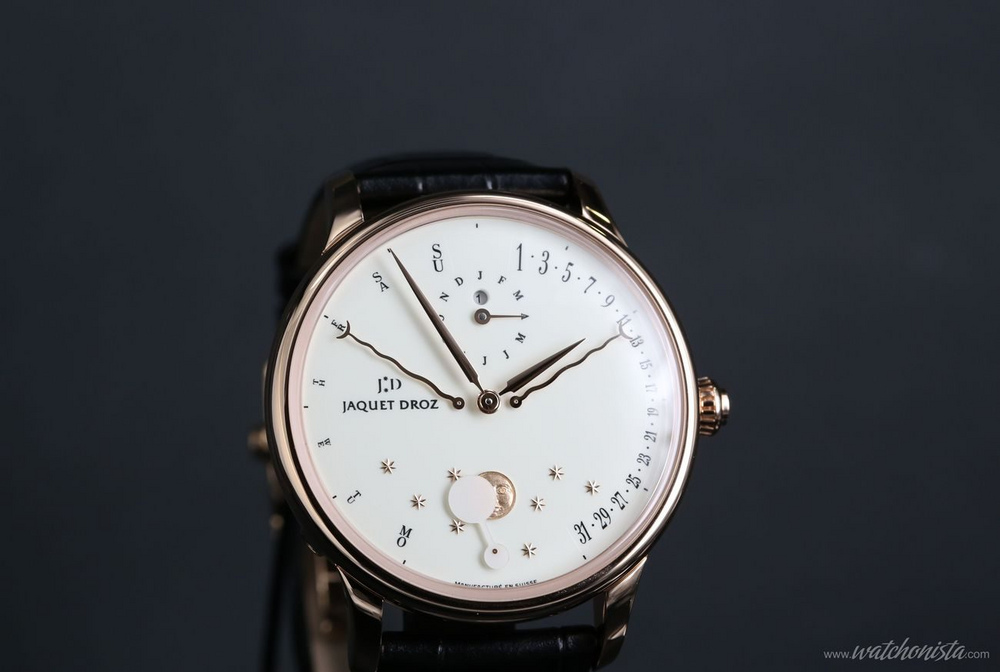
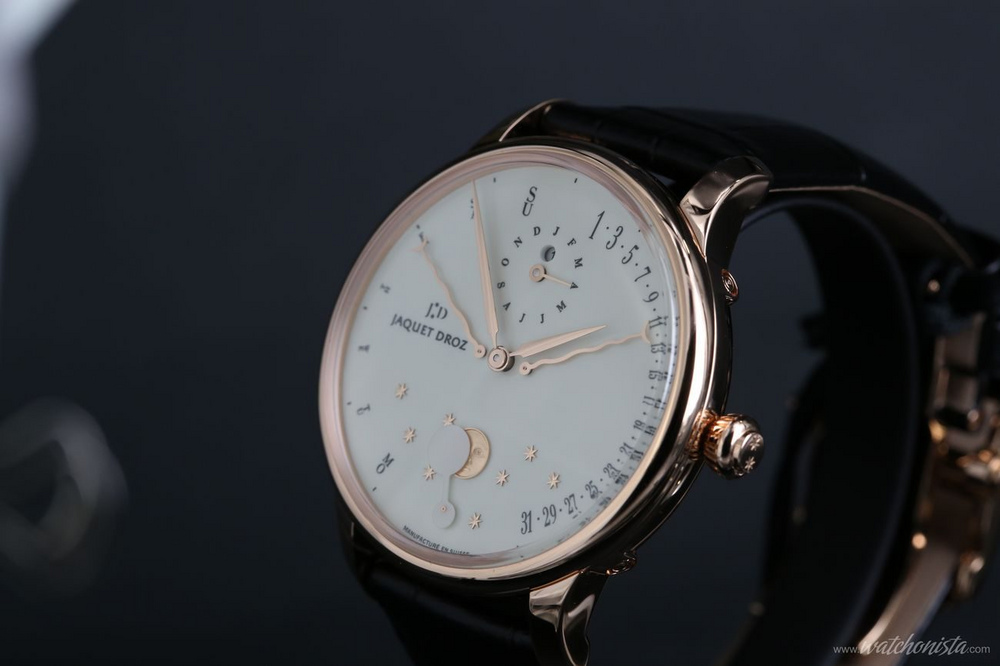
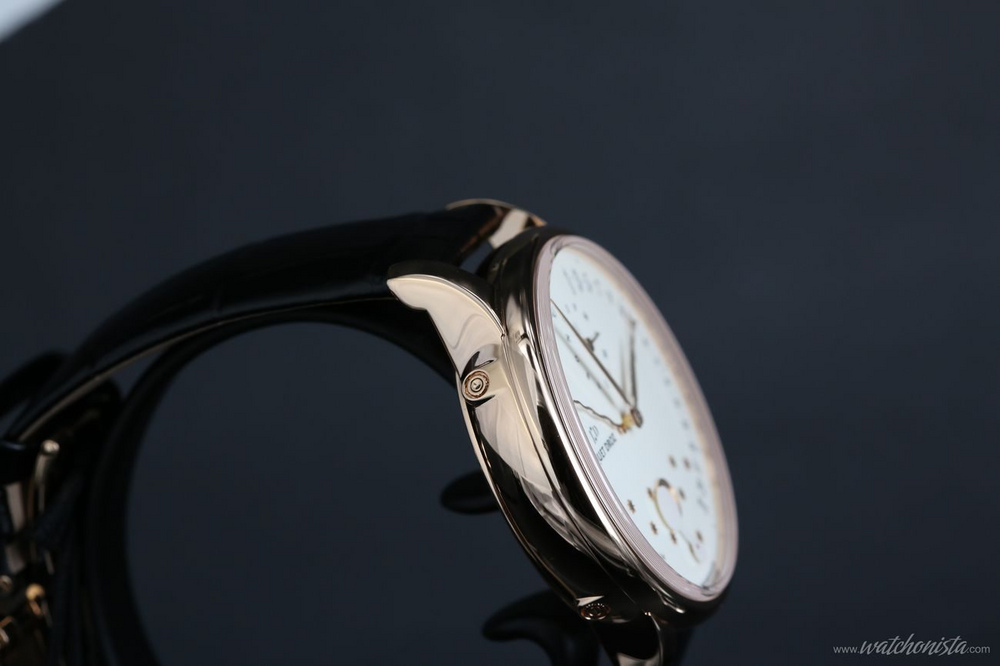
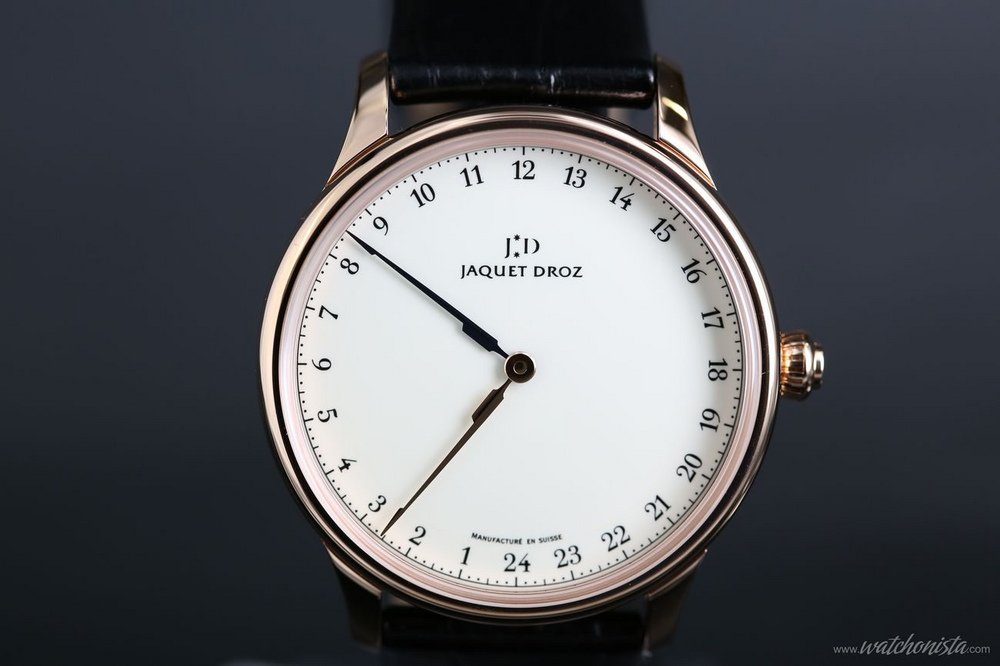
Comment